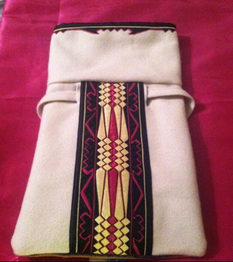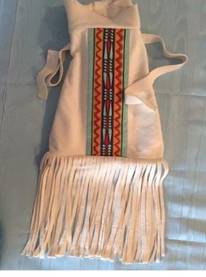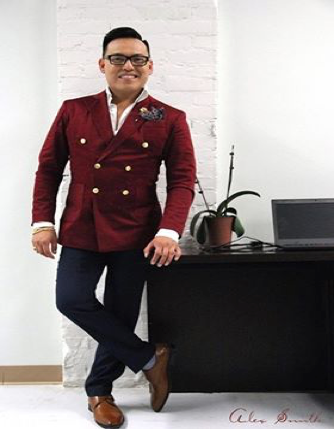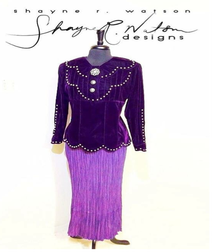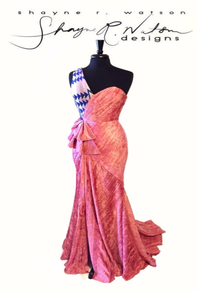Johnnie Bia, Jr. Diné College Psychology BA Intern, Office of Miss Navajo Nation
School back in 2002 and he also took some credits with Dine College before he transferred down to Phoenix Valley where he went to Scottsdale Culinary Institute- Le Cordon Bleu. He resides in Phoenix Valley nowadays where he is an Executive Chef. Kurtis was first curious about how people made ceremonial blankets when he would attend NAC peyote ceremonies. He then finally took it upon himself to learn how to sew. From the encouragement of one of his good brothers, he was able to learn how to sew with a sewing machine. His first projects were for a giveaway items for his little sister’s peyote ceremony.
material/colors and how the customer wants their product to function. Kurtis feels that he is at an “Okay” level for his sewing skills and techniques because he believes that you cannot judge your own self on your work. But he does stress that he puts his whole self into his work, reminding others that you have to take care of yourself first - be in a good physical state and good mindset. If there is something wrong with you or not feeling good, it will be difficult to fold or to sew. People don't want individuals who are falling apart to create their pieces just like they don't want your blankets or bags to be falling apart - people can judge you for that so put in your best efforts. You are the first one that needs to be healthy before you start working on a project. You want your customer to feel good and to take care of your products
through their schedule. Kurtis mentioned that he takes care of his sewing abilities because it was given and he has been blessed with it. Once you figure it out and master it, just take good care of it. Sometimes it works in your favor and sometimes it difficult to work through problems that pop up. Either way, it is something you can’t just give it away or push it off to the side because it is a part of your livelihood. You put your mind into it, you made it a part of yourself. The designs and colors you put on the projects is a part of you. A person must give themselves to that gift that was given to them. There’s good thoughts, prayers, and songs that go into it, a person will have some teachings from it. He/she can make a good living with it, whatever they want they can obtain it through sewing.
Sewing can build up your self-esteem and self-worth by seeing the happy faces of your customers. You feel proud and good within yourself when you know that people are amazed from your blankets & bags. They feel thankful and happy about your work so when they Thank You, it moves or touches your mind, heart, and soul. Sewing can give and take relationships with family, friends and relatives. When working on a blanket or bag, you are using and sacrificing your time away from family, friends, and relatives. It helps to maintain a good relationship by setting a good example of knowing how to sew a ceremonial blankets and bags. It can be good and bad depending on how your family, friends, and relatives take it. For Kurtis, sewing holds a significant and spiritual place in his life - putting himself out there for self-preservation, self-deaeration and away from self-destruction. He found something that he could put spiritual value into so that he wouldn’t harm himself or anybody else. For Kurtis, he wants to live a good life through his sewing, it can put a person in check and can leave them in a good place. Your relationships are based on what you put out for people. Sewing blankets and bags coincides with that output of his values, beliefs, and values. Kurtis takes time for prayer by finding it is best that a person should be in a clear mind, in a state of trancendency when dealing with spiritual instruments. Kurtis listens to peyote music because it helps a person to keep going as they work on a project. Singing along with the music while folding or sewing is always good to do because it helps you to get into it. By doing that, it’s a prayer in a song that goes along with and within a blanket and bag. Kurtis mentions the positive activities that a person can do for their spiritual well-being is knowing that it has to be you, “Taa’hwiajitee’”. Praying is the main thing that a person can do for themselves. You can give someone money to help say a prayer for you, but what if things don’t go your way. It will be easy to blame that person for nothing saying a right prayer for you. So it is best to pray for yourself, because that will help you to believe it by saying those words that come out of your mouth. Praying is the only and best way to keep your spiritual-self going. In conclusion, there are a lot of things that go into folding and sewing Native American Church peyote blankets and bags. Being in good physical health within a person is important, because they have to be up to doing the work. Having a clear and positive mind helps a person to really get into folding and sewing. It helps an artist feel good emotionally through the customer’s reactions of the final completed product. The spiritual aspect is the main important one to focus on because people are going to be using the blankets and bags around a peyote ceremony. In a way an artist must be in a spiritual mindset, spiritual feeling, and to live that spiritual lifestyle. It is having respect for the gift of folding and sewing blankets and bags.
4 Comments
From the Three Tiered Navajo Skirts to Contemporary Sewing: Holistic Well-being Through Dress Making4/24/2018 Johnnie Bia, Jr. Diné College Psychology BA Intern, Office of Miss Navajo Nation
the three tiers of the skirt that trace our Diné women's journey through their childhood, adulthood, and elderly years. And as of late, we have seen a rise in contemporary takes of this style walk the fashion run ways from Arizona to New York to Europe. Despite its travels, the Navajo tailors and seamstresses continue to root themselves in the cultural nuances of this cultural arts practice. I am in no way close to a tailor, but I do know someone who is!
and old style pleats on the bust, the back, and the sleeves of each blouse. Shayne’s strategic plan to attaining success in his future with sewing is built around a self-owned small company. So in the future hiring staff will be beneficial. Together they could maybe triple or quadruple their work and their earnings each day rather than one person making one garment and finishing it for the next 2 to 3 days. Sewing contributes to his overall physical health. He explained - you are always on your feet, always having your hand gestures move softly, quickly, steadily, and constantly. Some positive activities outside of the act of sewing that can enhance your work is eating healthy. Through proper nutrition you make sure you get your vitamins, water intake, and also protein intake with fruits and other organic items. One unique aspect that Shayne brought up was keeping up with your hygiene as another way to improve your work - when you are working, showering at least twice a day, one in the morning when you get up and then always one at night before you sleep is important. You may think this is a lot of showering but... because you don’t know what chemicals and fibers are on each fabric, its better to shower after each project for your health.
Shayne is satisfied of what he does because he can actually create an item or garment for someone who cannot create it themselves. But each piece is so unique that it brings to them a unique feeling of having something created just for them.
Meditation also helps positively build your mental health, not only during the project but also before. Mediation is your quiet time, where you can actually think clearly and prepare yourself for your next garment order. It also helps you to trouble shoot any issues that you may have run into. From a spiritual perspective, Shayne learned his sewing techniques from his great grandmother and he will always be able to take those teachings with him wherever he goes. In this way, what he sews not only connects him to his grandmother but he also extends his grandmother's teachings to those who receive his work. In addition to the connections to his grandmother, Shayne feels a sense of connectedness and pride for the value of Navajo culture. In doing his work and creating new garment, he always has tied his beliefs into Navajo culture and history because that is how he creates his garments and designs. For these reasons, he is actually creating work that coincides with tradition - from old style traditional wear to contemporary and modern wear. Finally, he also points out that prayer is also something that you can do while you are in the midst of your sewing because that’ll help you so many ways. Prayers gives you more spirit and sets your mind in your current sewing task. In conclusion, as a tailor or a seamstress, you impact both your own holistic well-being and that of the clients or recipients of the clothes you make. This makes perfect sense to me - I know how I feel when I put on a freshly pressed shirt made especially for me. It makes me stand just a few centimeters taller and feel just a bit more confident. We have come a long way since our days of loinclothes and rug dresses, but our clothing today and sewing of those clothes utilize many of those skills and techniques that help to reconnect us to our Dine holistic self. Thanks, Shayne, for all your insight! And stay tuned, blog readers, Miss Navajo will be hosting a skirt making workshop this summer as part of her Cultural Arts Holistic Well-Being Workshop Series :)
If you are just now joining our blog series, please take some time to review some of the past Holistic Well-Being blogs from this 10 - week series! |
Categories
All
Archives
October 2021
|
SocialsALL PHOTOS IMAGES ARE COPYRIGHT PROTECTED. PHOTO IMAGES USE IS SUBJECT TO PERMISSION BY THE NAVAJO CULTURAL ARTS PROGRAM. NO FORM OF REPRODUCTION IS PERMITTED WITHOUT WRITTEN PERMISSION FROM THE NAVAJO CULTURAL ARTS PROGRAM. |
Featured Pages |




